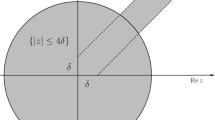Abstract
In their previous papers, the authors have considered the possibility of applying the theory of motion for nonholonomic systems with high-order constraints to solving one of the main problems of the control theory. This is a problem of transporting a mechanical system with a finite number of degrees of freedom from a given phase state to another given phase state during a fixed time. It was shown that, when solving such a problem using the Pontryagin maximum principle with minimization of the integral of the control force squared, a nonholonomic high-order constraint is realized continuously during the motion of the system. However, in this case, one can also apply a generalized Gauss principle, which is commonly used in the motion of nonholonomic systems with high-order constraints. It is essential that the latter principle makes it possible to find the control as a polynomial, while the use of the Pontryagin maximum principle yields the control containing harmonics with natural frequencies of the system. The latter fact determines increasing the amplitude of oscillation of the system if the time of motion is long. Besides this, a generalized Gauss principle allows us to formulate and solve extended boundary problems in which along with the conditions for generalized coordinates and velocities at the beginning and at the end of motion, the values of any-order derivatives of the coordinates are introduced at the same time instants. This makes it possible to find the control without jumps at the beginning and at the end of motion. The theory presented has been demonstrated when solving the problem of the control of horizontal motion of a trolley with pendulums. A similar problem can be considered as a model, since when the parameters are chosen correspondingly it becomes equivalent to the problem of suppression of oscillations of a given elastic body some cross-section of which should move by a given distance in a fixed time. The equivalence of these problems significantly widens the range of possible applications of the problem of a trolley with pendulums. The previous solution of the problem has been reduced to the selection of a horizontal force that is a solution to the formulated problem. In the present paper, it is offered to seek an acceleration of a trolley with which it moves by a given distance in a fixed time, as a time function but not a force applied to the trolley, while the velocities and accelerations are equal to zero at the beginning and end of motion. In this new problem, the rotation angles of pendulums are the principal coordinates. This makes it possible to find a sought acceleration of a trolley on the basis of a generalized Gauss principle according to the technique developed before. Knowing the motion of a trolley and pendulums it is easy to determine the required control force. The results of numerical calculations are presented.
Similar content being viewed by others
References
N. N. Moiseev, Yu. P. Ivanilov, and E. M. Stolyarova, Optimization Methods (Nauka, Moscow, 1978) [in Russian].
L. S. Pontryagin, V. G. Boltyanskii, R. V. Gamkrelidze, and E. F. Mishchenko, Mathematical Theory of Optimal Processes (Nauka, Moscow, 1961; Gordon and Breach, New York, 1986).
F. L. Chernous’ko and N. V. Banichuk, Variational Problems in Mechanics and Control (Numerical Methods) (Nauka, Moscow, 1973) [in Russian].
R. Bellman, Dynamic Programming (Princeton Univ. Press, Princeton, 1957; Inostrannaya Literatura, Moscow, 1960).
F. L. Chernous’ko, L. D. Akulenko, and B. N. Sokolov, Control of Oscillations (Nauka, Moscow, 1980) [in Russian].
N. N. Polyakhov, S. A. Zegzhda, and M. P. Yushkov, “Generalization of the Gauss principle to the case of nonholonomic high-order systems,” Dokl. Akad. Nauk SSSR 269, 1328–1330 (1983).
M. P. Yushkov, S. A. Zegzhda, Sh. Kh. Soltakhanov, and A. A. Pashkina, “On the relationship between control theory and nonholonomic mechanics,” Vestn. St. Petersburg Univ.: Math. 47, 181–188 (2014).
G. V. Kostin and V. V. Saurin, “Integro-differential approach to solving problems of linear elasticity theory,” Dokl. Phys. 50, 535–538 (2005).
G. V. Kostin and V. V. Saurin, “Modeling and optimization of elastic system motions by the method of integrodifferential relations,” Dokl. Math. 73, 469–472 (2006).
M. A. Chuev, “Differential equations of program motions of a mechanical system,” Mech. Solids 43, 153–164 (2008).
Gavrilov D. N. and Zegzhda S. A. “Damping of vibrations of an elastic body during its motion,” Vestn. St. Petersburg Univ.: Math. 45 (3), 73–83 (2012).
Author information
Authors and Affiliations
Corresponding author
Additional information
Original Russian Text © S.A. Zegzhda, E.A. Shatrov, M.P. Yushkov, 2016, published in Vestnik Sankt-Peterburgskogo Universiteta. Seriya 1. Matematika, Mekhanika, Astronomiya, 2016, No. 2, pp. 286–295.
About this article
Cite this article
Zegzhda, S.A., Shatrov, E.A. & Yushkov, M.P. A New approach to finding the control that transports a system from one phase state to another. Vestnik St.Petersb. Univ.Math. 49, 183–190 (2016). https://doi.org/10.3103/S106345411602014X
Received:
Published:
Issue Date:
DOI: https://doi.org/10.3103/S106345411602014X




